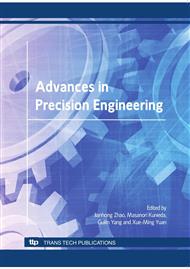p.795
p.801
p.806
p.811
p.816
p.821
p.826
p.831
p.836
Development of Flexible Worktable for Endmilling Based on Parallel Mechanism
Abstract:
Parallel mechanism has many advantages, such as high stiffness, high accuracy, high degree of freedom (DOF), etc. These fine features are suitable for work table of machine tools for production of recent complicated designs. In this study, six axes linear-actuated parallel mechanism was chosen as the basic design for work table. First, geometrical parameters of the table were designed to satisfy the required movable range with minimum cutting load. Then, the work table was actually constructed and its performance was evaluated. From positioning accuracy measurement, it was found that the table is suitable to be used for machining of complicated products. On the other hand, from actual cutting tests of primitive shapes using chemical wood and measurement of the machined shapes, potential of the table for real cutting application was confirmed.
Info:
Periodical:
Pages:
826-830
Citation:
Online since:
September 2010
Authors:
Price:
Сopyright:
© 2010 Trans Tech Publications Ltd. All Rights Reserved
Share:
Citation:


